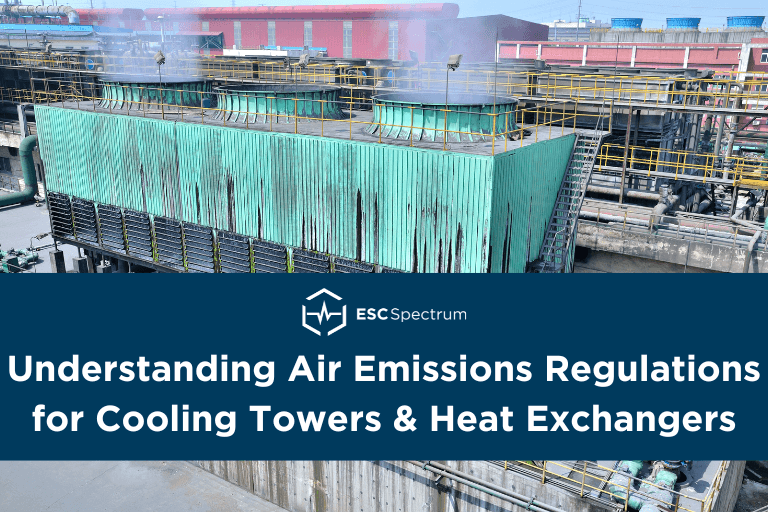What Are Industrial Process Cooling Towers and Heat Exchangers?
An industrial process cooling tower (IPCT) means any cooling tower that is used to remove heat that is produced as an input or output of a chemical or industrial process(es), as well as any cooling tower that cools industrial processes in combination with any heating, ventilation, or air conditioning system.
In other words, a cooling tower is a large structure used in various industries to remove excess heat from machinery, equipment, or processes. These towers work by circulating water through heat exchangers or coils, allowing the water to absorb heat and then releasing it through evaporation or other cooling methods.
A heat exchanger associated with industrial process cooling towers is a device that transfers heat between two or more fluids in an industrial setting, often involving cooling processes regulated under the National Emission Standards for Hazardous Air Pollutants (NESHAP).
General NSR Conditions for Cooling Towers & Heat Exchangers Nationwide
The New Source Review (NSR) guidelines for special conditions, particularly for cooling towers and heat exchangers, are an essential aspect of environmental regulation.
NSR Guidance for Cooling Towers
NSR stands for New Source Review, which is a process regulated by environmental agencies to ensure that new industrial facilities or modifications to existing ones meet certain air quality standards.
Each state may have its own requirements as part of its NSR review, and its individual state contacts can provide more details.
Learn more about National Emission Standards for Hazardous Air Pollutants from Petroleum Refineries, specifically on 40 CFR Part 63 Subpart CC. Heat exchanger requirements fall under this rule.
Cooling Tower & Heat Exchanger Emissions Monitoring in Texas
VOC Monitoring and Emission Control:
Monitoring VOC Leakage:
- Monthly monitoring of cooling tower water for volatile organic compounds (VOCs) leakage from heat exchangers is required. This must adhere to the TCEQ Sampling Procedures Manual, Appendix P (dated January 2003 or later editions), or an approved air stripping method. Read more about how your facility must monitor for leaks in cooling water.
Alternate Sampling Methods:
- If Appendix P is considered too stringent, such as in renewals, an Organic Vapor Analyzer (OVA) can be used to monitor the air used for stripping the cooling water instead of a Thermal VOC Analyzer (TVA).
Detection Levels and Calibration:
- The sample port should be located at the top of the horizontal section of the water line returning to the cooling tower.
- The minimum detection level for the testing system must not exceed 0.15 ppmw VOC in the water and 2.50 ppmv VOC in the air.
- Calibration standards must include zero ppmv and 10 ppmv VOC in the air (as methane).
Faulty Equipment and Maintenance:
- VOC concentrations above 0.08 ppmw (or 0.15 ppmw if OVA is used) indicate faulty equipment.
- Such equipment must be repaired promptly, no later than the next scheduled shutdown of the process unit.
Emission Limits:
- VOC concentrations in the cooling water returning to the tower must not exceed the maximum acceptable concentration (determined based on MAERT values).
- Exceeding this limit means emissions are unauthorized, and repairs cannot be delayed under this permit condition.
- Monitoring and maintenance efforts must be documented.
Particulate Matter (PM) Monitoring:
Daily Sampling:
- Cooling water should be sampled daily for total dissolved solids (TDS), as TDS in cooling water drift is considered emitted as PM10.
Approval:
- The sampling methods must be approved by the TCEQ Compliance Support Division.
Source: TCEQ Boiler Plate Conditions
Additional Monitoring Requirements for Cooling Towers & Heat Exchangers
Depending on the plant’s location, the facility may have additional monitoring requirements for cooling towers or heat exchangers under the NSR program, depending on your area’s attainment status.
Reasonably Available Control Technology is required on existing sources in areas that are not meeting national ambient air quality standards (i.e., non-attainment areas).
Best Available Control Technology is required on major new or modified sources in clean areas (i.e., attainment areas).
Lowest Achievable Emission Rate is required on major new or modified sources in non-attainment areas.
In Conclusion
These guidelines help in controlling VOC and PM emissions in Refineries’ cooling towers and heat exchangers located in Texas, ensuring the integrity of equipment, and maintaining compliance with regulatory standards. Repair any faulty equipment quickly, ensure VOC emissions are minimized, and keep detailed records of your monitoring and maintenance activities.
By following these steps, you can keep your cooling tower operating safely and within regulatory limits.
For any specific application or permit condition, it is crucial to refer to the most current guidelines.
How ESC Spectrum Can Help With Cooling Towers and Heat Exchangers
Do you have cooling towers or heat exchangers? At ESC Spectrum, we can help monitor operating parameters such as flow or pressure for these systems to help demonstrate compliance. We can help configure different systems within your facility to measure parameters within our data acquisition system, StackVision or Prism.
Our Reporting team is on standby to help your facility meet compliance in its reporting to the EPA. Using our industry-leading Data Acquisition Systems, StackVision and Prism can monitor heat exchangers or cooling towers compliance or operating parameters.
Learn more about our Reporting Services today.

Taylor Hempel - Marketing Specialist II
Taylor Hempel is a skilled marketer specializing in content creation, social media management, and driving customer engagement. With a BBA in Marketing from the University of Texas at San Antonio, she joined ESC Spectrum in February 2022. Taylor is adept at crafting informative content about continuous emissions monitoring systems, its components and data acquisition systems allowing her to craft content that educates and informs industry professionals.
Contact Taylor at thempel@escspectrum.com for questions or comments.


